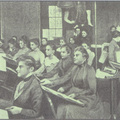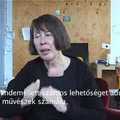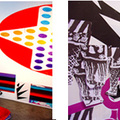What are we talking about, and what are we pass over in silence in a gallery where there is no exhibition? There are only chairs to sit down – and speak or not to speak. Our project aims to get a sight of what happens nowadays when several dozen hungarian people sits down and begins to talk about which they here-and-now interested in.
Erika Baglyas interprets the possibility of an one-mounth-exhibition at the Óbudai Társaskör Gallery as a sequence of events. The conception – which is the result of the shared thinking of three friends – entails four fixed elements. First, the exhibition can be visited only at specified times. Second, the gallery room chairs should be placed in concentric circles to sit down. Third, two group leaders are present during the meetings. Fourth, we consider the project's content and message which is displayed at the exhibition’s room during the four-time course.
Now the Gallery functions not as an exhibition room, but – following the ancient Greek agora – as a public forum: an open space for communication. A Large Group will be assembled four times, and it will provide the communication framework within which the participants could express their feelings and thoughts concerning them then and there. The desires, fears and fantasies, which are the movers of this community, could be appeared during the meetings at this social space created from time to time. On the events – which are open to everyone – all the participants have the chance to speak and to listen. Taking part on the events is possible at any time, independently of each other. We make audio recording of the conversations for the purpose that we could interpret the common communication’s lines of force and direction after the four occasions.
At this time, the everyday exhibition-situation at the space of the Óbudai Társaskör Gallery will be suspended. Thus, not only the function of the exhibition space will be temporary changed, but the creator/artist and the viewer/recipient/participant roles and definitions will be altered, the gap between them will be decreased. Now the ‘creator’ means one or more artists no more; the ‘product’ is not pre-established, therefore the presentation of this – in classical sense – will not be made. The exhibition space in this case functions as an offered space; the artist is the catalyst of the process, and the organizers of the project are the developers of the framework of the events. The roles of ‘artist’ and ‘audience’ would be re-evaluated. In this case, the ‘exhibition visitor’ becomes a collective creator, and her feelings and thoughts become content.
People live in larger group in society have their individual pictures of things defining their everyday social life and relations without personal meeting and without having the chance of discussion about them. Only the linguistic and cultural community and common fate produces common knowledge, common prejudices, attitudes and fantasies and different world-views. Human communities have the ancient experience that the most accurate picture of reality could be gained only if they knowingly start to talk each other about questions they are interested in, giving space to expand the variety of possible approaches and experience.
The historical, cultural and political motives which are written to the multi-generational experiences of personal life could markedly deepen, circumscribe an converse the private knowledge of small communities. In a family or other small group we could even know what’s behind the silence, but on a level of a larger group or community there is no longer common knowledge on which we pass over in silent. There are times when almost everyone knows what is not desirable to talk about at social level. Usually, it’s linked up with strong public-access control, and with the threatening consequences of different solutions. In this case, however, the individual knowledge conjoin to common not-knowledge (or ignorance), and thus not become public.
According to our current knowledge, a great part of the emotional-relational disturbances – at times embodied in the form of disease – derived from the unprocessed conflicts of the family or other environment, from seemingly incommunicable generation secrets, from concealments, and from faking what has happened, from faking the reality.
These implications had been appeared ever clearly from the beginning of last century, just like the idea that with the normalization of our relationships – which inevitably involves the deepening of our self-knowledge – our mental disorders could be cured. An increasingly wider scope of connections was involved in the healing process, so the healing power of the community is also appeared as an effective scene. Thus was created the first therapeutic community in England, whose creator was Robert N. Rapoport. The soul of the healing community is the Large Group where participants are free to discuss their experiences, their relations with each other, while each partaker brings along her “home-made” stuff, her social reality (as well). The idea that what holds together many people is the same that holds together an individual was parturient.
What is a Large Group?
Large Group is a forum aimed to uncover and understand the social functions, hidden conflicts and organizing fantasies of larger establishments. A space of communication, working with fixed frameworks, where fifty – sixty people are free to speak or listen. There is no pre-defined topic: the group leaders try to aid the appearance the motifs which deeply concern the participants. This method is, as an emphatic element, commonly used in institutions healing mental disorders. Our project transfers this form to the context of art, as a sort of display of the public.
General framework
- 2 group leaders, 2-3 support staff
- Concentrically arranged rows of seats. Everyone is free to choose her place
- 1 _ hour period
Each participant has the chance at the four specified time to sit down, talk or listen for 1 _ hour at the exhibition room. Like in all Large Group, here will be what we bring and what we make out of this. This project is to provide a model to a situation in which the members of a larger community form an ad hoc group, where, as strange or familiar persons, they could experience and endure the less personal world of the Large Group, the deep uncertainty and abandonedness, and could create a small world where the touching of Personal and Common become palpable. If we try to share with each other our feelings and thoughts occuring there, we could have a picture of the fantasies organizing our wider community, and of the possible lines of force of dialogue. This jointly purchased common knowledge might be able to heal the disturbances of the relations of larger human communities.
Conception: Erika Baglyas, Zsuzsanna Tóth, Zsolt Zalka
Group Leaders: Piroska Milák and Zsolt Zalka
Dates:
2011. 05.03. 19.00-20.30
2011. 05.10. 19.00-20.30
2011. 05.17. 19.00-20.30
2011. 05.24. 19.00-20.30
Location:
Óbudai Társaskör Galéria
1036, Budapest, Kiskorona u. 7.
Robert N. Rapoport: Community as Doctor, In: Tavistock Publications Ltd., London, 1960.







